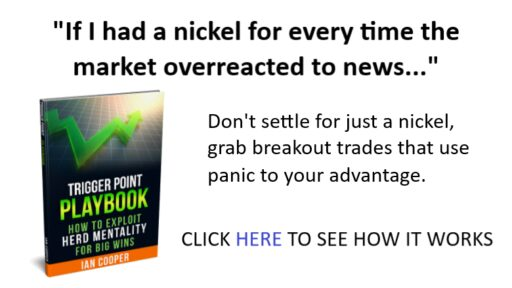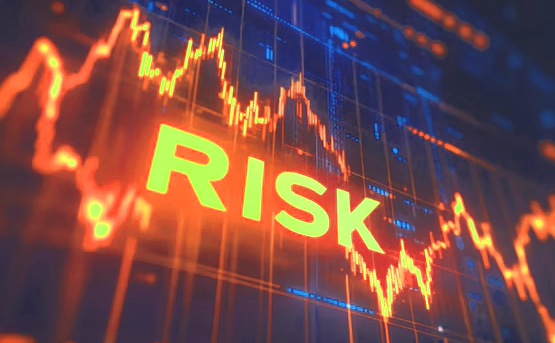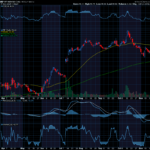by Lee Gettess
Risk is the area of trading that we have the greatest amount of control. Consequently, what we should try to do is equalize the risk on each trade. We can only make educated guesses as to which trades should be the big winners, but if we risk approximately the same amount on each trade, then we should have an adequate number of contracts on when the big trade presents itself. We can accomplish this by simply choosing a number between 0 and 100 and risking that percentage on every trade.
Let’s assume you have a $20,000 trading account, and you have determined you are comfortable with risking 10% per trade. Multiplying $20,000 by .10 (10%) gives you $2,000. This is the amount you can risk on a trade. Now, let’s say you are trading a 3 minute S&P 500 chart and are using twice the average true range as your stop point. If the average true range is 35 points, that means a 70 point stop, or risk of $350, since each S&P point is worth $5. You would then divide $2,000 (the amount you can risk) by $350 (the amount or risk in this trade) – 2000 divided by 350 is 5.7143857. It is not necessary to take your calculation out to any decimals places since you can’t trade partial contracts. You merely truncate off the decimal part, and you are left with 5, which is the number of contracts you can trade.

It is important that you understand you DO NOT ROUND your answer. You only pay attention to the whole number and eliminate the decimals. In other words, you always round the answer DOWN to the whole number. If say, you had the $20,000 account and the same S&P trade set up, but you only wanted to risk 5% per trade, here is how it would work: 5% of $20,000 is 20000 multiplied by .05 or $1,000. Your risk is $350, so you divide 1000 by 350, which is 2.857. Even though the answer is almost 3, you round down to the nearest whole number, which means you can trade 2 contracts.
The math is done the same way regardless of how large your account is, how much risk is in the trade, and what percentage of your account you wish to risk. The beauty of this method is that it has you scaling back contracts when you are experiencing a drawdown and your account is shrinking, but allows you to trade more contracts as your account grows. You simply multiply your account size by the percentage you have chosen, then divide that amount by the risk in the given trade, and trade the whole number answer in contracts.
Incidentally, what would happen if you had a $20,000 account and were willing to risk 2% and the trade you were looking at had $2,500 risk? The answer is: You can’t take the trade! – 2% of $20,000 is $400 and 400 divided by 2500 leaves you no whole number answer at all. Filtering out trades in this manner prevents you from taking trades where the risk is too large for you.
So, how much is the correct amount to risk? That is a question to which there is no universal answer. Everyone has their own personal tolerance for risk. Everyone has a different size account. Everyone has the right to change how they feel about risk as time goes on. It is not unusual for someone with a $5,000 account to feel comfortable risking 20% per trade. The odds for success may be small, but the risk/reward makes it reasonable. If that same person has some success, however, and trades that $5,000 up to $20,000 it is fairly unlikely that they will still be willing to risk 20% per trade! Most folks tend to risk less as their total amount of money grows. The more you risk, the greater the chances are that a string of losses will wipe out your account. The less you risk, the less money you are capable of making on a percentage basis.
You have to choose what the correct level of risk is for you. The important thing is for you to honor that risk level until you have generated enough profits in your account to allow you to lower your risk parameters.
I have deliberately not given hard and fast parameters for how much should be risked or how quickly to begin taking profits. One of the primary factors in allowing someone to have success in the markets is that you should be utilizing a methodology that is comfortable and suits your temperament. Some people need to hang on for huge wins while cutting their losses quickly. Those people have to be prepared to take more losses on average than wins. Conversely, some people need the positive reinforcement that consistent wins provide, even at the expense of taking some rather large losses. Consequently, those people can risk larger amounts, but then take profits at smaller targets. This will allow them to trade with far greater accuracy. The comparison of total profits between these two extremes is irrelevant. As long as they both end up with total profits, the “best” one is the one that fits your personality best.
In my own experience, I have had the most success with risking about twice the 7 bar average true range for my initial stop, then looking to take profits when the market has moved that distance in my favor. I then begin trailing the stop on the remaining position. Generally, I try to protect about 50% of the open equity on that last piece of the position.
This is not necessarily a recommendation that you should use this particular combination for your trading. It is merely what has proven suitable for me, and leave the choice of parameters for your trading up to your discretion.











Recent Comments